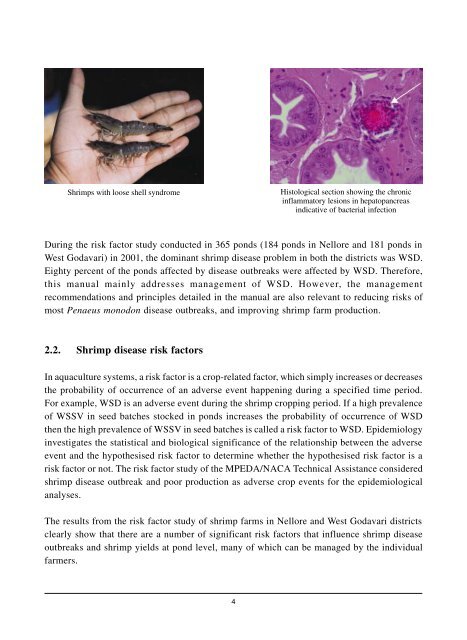Shrimp Health Management Extension Manual - Library - Network of ...
Shrimp Health Management Extension Manual - Library - Network of ...
Shrimp Health Management Extension Manual - Library - Network of ...
Create successful ePaper yourself
Turn your PDF publications into a flip-book with our unique Google optimized e-Paper software.
<strong>Shrimp</strong>s with loose shell syndromeHistological section showing the chronicinflammatory lesions in hepatopancreasindicative <strong>of</strong> bacterial infectionDuring the risk factor study conducted in 365 ponds (184 ponds in Nellore and 181 ponds inWest Godavari) in 2001, the dominant shrimp disease problem in both the districts was WSD.Eighty percent <strong>of</strong> the ponds affected by disease outbreaks were affected by WSD. Therefore,this manual mainly addresses management <strong>of</strong> WSD. However, the managementrecommendations and principles detailed in the manual are also relevant to reducing risks <strong>of</strong>most Penaeus monodon disease outbreaks, and improving shrimp farm production.2.2. <strong>Shrimp</strong> disease risk factorsIn aquaculture systems, a risk factor is a crop-related factor, which simply increases or decreasesthe probability <strong>of</strong> occurrence <strong>of</strong> an adverse event happening during a specified time period.For example, WSD is an adverse event during the shrimp cropping period. If a high prevalence<strong>of</strong> WSSV in seed batches stocked in ponds increases the probability <strong>of</strong> occurrence <strong>of</strong> WSDthen the high prevalence <strong>of</strong> WSSV in seed batches is called a risk factor to WSD. Epidemiologyinvestigates the statistical and biological significance <strong>of</strong> the relationship between the adverseevent and the hypothesised risk factor to determine whether the hypothesised risk factor is arisk factor or not. The risk factor study <strong>of</strong> the MPEDA/NACA Technical Assistance consideredshrimp disease outbreak and poor production as adverse crop events for the epidemiologicalanalyses.The results from the risk factor study <strong>of</strong> shrimp farms in Nellore and West Godavari districtsclearly show that there are a number <strong>of</strong> significant risk factors that influence shrimp diseaseoutbreaks and shrimp yields at pond level, many <strong>of</strong> which can be managed by the individualfarmers.4
















